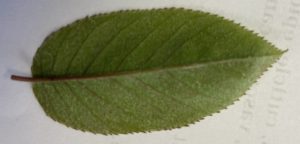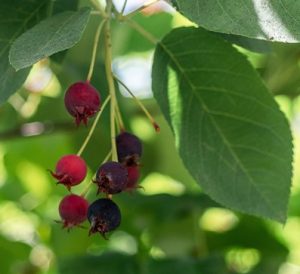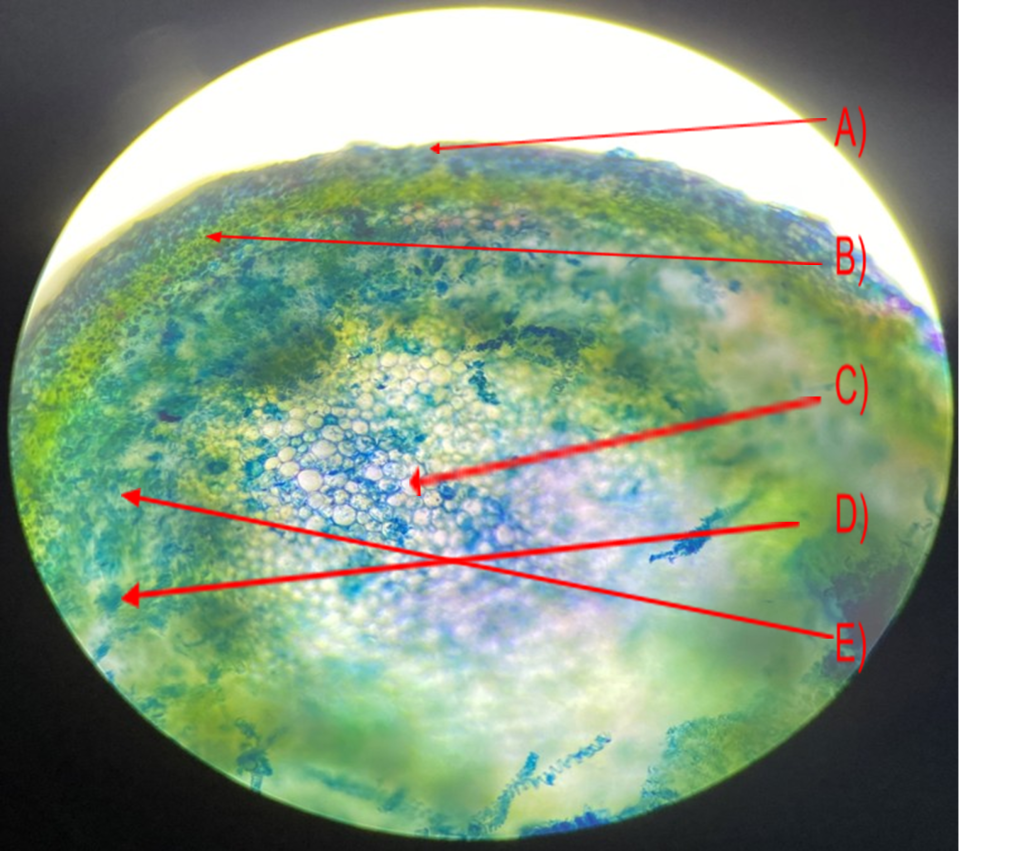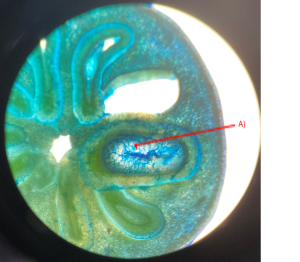1.5 Amelanchier Arborea
Aiden Braun
Amelanchier Arborea
Author: Aiden Braun
1. Plant Description
Amelanchier arborea, commonly known as Downy Serviceberry, Common Serviceberry and Juneberry due to the fine “hairs” on the leaves and twigs of the tree and the time of year it flowers. This plant is a:
- Perennial: reblooms and resumes growth each year
- Angiosperm: A deciduous tree that flowers in the early spring
- Woody Stem: Stem, branches and twigs are lignified (woody)
- Eudicot: This species has 2 embryonic leaves
- Roots: Roots stay relatively close to the surface, good for urban environments and rocky soils
- Monoecious: Contains both male and female flowers on the same structure
2. Identification
Location: Commonly found in open rocky forests, forest understory, forest edges, and stream banks (Lady Bird Johnson Wildflower Center, 2023)
Flowering:
Flowering can start as early as March but typically blooms in April in SW Ontario. Flowers are grown near the tips of new leafy shoots in erect clusters known as racemes, with 4-10 flowers on each raceme (Minnesota Wildflowers, n.d.). Flowers are white in colour but can also be described as pale pink with a subtle fragrance (Chadwick, 2016). Flowers are star-shaped with 4-5 petals per flower with each petal roughly 8-12 mm in length with a flower diameter of 15-25 mm (Government of Canada, 2015). At the centre of the flower are roughly 20 stamens, with the stamens having brown anthers and white filaments; near the stamens is the pistil with a single style (Minnesota Wildflowers, n.d.). Due to the tree being monoecious, it can be produced asexually and can be hybridized with other trees in the same genus Amelanchier.

Leaves: The colour of the leaves is green, but in the autumn, the colours can be a variety of colours, such as yellow, burgundy, and orange (North Carolina Extension Gardener Plant Toolbox, n.d.). The leaves are roughly 5-9 cm in length and roughly 3-5 cm in width and are attached with a slender petiole roughly 2-4 cm in length (Government of Canada, 2015; Lady Bird Johnson Wildflower Center, 2023). The leaves grow alternately on the shoot and are described as simple, with an oval shape that comes to a tapered point at the end of the leaf (Government of Canada, 2015; Lady Bird Johnson Wildflower Center, 2023).
The border of the leaf is denticulate, finely toothed, with roughly 25 each side teeth, as the teeth approach the petiole, the leaf tends to become mostly toothless (Government of Canada, 2015). The veins of the leaves are straight and parallel, with roughly 12 veins on each side of the leaf (Government of Canada, 2015). Young leaves are densely covered with wool-like hairs, particularly on the underside of the leaves, and as the tree matures, it becomes less hairy, with leaves looking glabrous on the top while some hairs can remain on the bottom and tend to follow the vascular structure of the leaf (Lady Bird Johnson Wildflower Center, 2023; North Carolina Extension Gardener Plant Toolbox, n.d.).

3. Cultivation
Germination: Recommended to plant in Autumn but can be planted during the spring; seedlings can emerge as late as the following spring. Best to be planted in Autumn as the cooler temperature provides a less stressful environment, as heat can cause too much stress for a young plant if not properly managed (Potts, 2020). Seeds can be planted in a medium consisting of equal parts perlite, peat, and vermiculite and be chilled at 4°C for 3 – 6 months. Germinate after being exposed to cool moist conditions. Seeds can remain viable for a few years if kept at near-freezing temperatures (How to grow serviceberry from seed, 2022).
Soil: Prefers moist soil, though is known to be moderately drought tolerant but can also tolerate excess water. Prefers soils with good drainage and pH that’s slightly acid to neutral, with a pH range of 5.5 – 7.0 (Chadwick 2016; Lady Bird Johnson Wildflower Center, 2023). Grows in a wide range of soil types, such as rocky, loamy, sandy, and clay soils (Chadwick, 2016; North Carolina Extension Gardener Plant Toolbox, n.d.).
Sunlight: Best to be planted in full sun (6+ hours of light) to light shade (2 – 6 hours of light).
Growth Expectation: A. arborea has smooth light grey bark, and oftentimes verges off into multiple trunks. It will typically grow 4.5 – 8 m tall with a trunk diameter of 15 – 45 cm (Amelanchier arborea, 2022). The tree has a medium growth rate, with an expected growth of 2.7 – 3.0 metres in a 5 – 8-year period. It is recommended to have 3.5 – 7.5 metres of growth space allotted for the tree canopy so as not to have any issues occur as the tree grows and matures.
4. Cultural History

A. arborea gets its name from North American colonizers, who used the tree to determine when to bury dead bodies after the winter (Potts, 2020). Since the flower bloomed in early spring, cemeteries used the tree blooming to determine when the permafrost melted and the ground was soft enough to dig; hence the flowers blooming were synonymous with funeral services (Potts, 2020). A. arborea produces edible berries from May but don’t typically ripen until late June to early August. Berries are comparable to blueberries in shape and first, appear to be green and fleshy and will turn red to purple-black in colour when ripe (Potts, 2020). Berries can and have been used by Aboriginals to be used to make jams, wines, jellies, or puddings (Bernheim Arboretum and Research Forest, n.d.; Government of Ontario, 2023; The Tree Pages, n.d.). The berries are a staple food for wildlife, with raccoons, squirrels, bears, chipmunks, and birds being frequently known to snack on the fruit produced (Bernheim Arboretum and Research Forest, n.d.; Pollen Library, n.d.). White-tailed deer are also known to snack on the leaves and twigs of the tree, making the tree a good barrier for protecting other plants or gardens (Backyard Ecology, 2018). The tree is also a host plant for some species of butterflies and moths (Backyard Ecology, 2018).
5. Life Cycle

Flowering: Flowering takes roughly 13 days, occurring from April to May (Honey Plants Calendar, n.d.). The flower itself only stays open for 3 – 4 days for pollination; afterwards, it starts to wilt.
Pollinators: Due to the early flowering of A. arborea, it provides an early source of nectar and pollen for a variety of insect species. It provides an early source of pollen and nectar for honey bees and other bee species, as well as some species of flies, butterflies, moths, and beetles, which subsequently help pollinate when feeding on the nectar produced (Potts, 2020).
Seeds: Seeds are produced by the fruit of the tree, and each berry has 4 – 10 seeds per fruit (Government of Canada, 2015). The sweet berry primarily attracts birds, which eat the fruit and help disperse seeds over a wider range (The Tree Pages, n.d.). The offspring of the mother plant are genetically different, but self-pollination is possible; however, internal measures such as separation of the stamen and pistil are taken by the plant to reduce self-pollination (The Biology Primer, n.d.).
Reproduction: A. arborea produces microsporocytes that will go through meiosis to produce haploid (n) microspores. These microspores will divide by the process of mitosis, producing sperm, known as pollen. Microsporocytes are housed in the anther, which is seen on top of the filaments of the flower, making the pollen accessible to pollinators. The carpel, which houses the ovary, forms a tube known as a style (The Biology Primer, n.d.). Atop the style is the stigma, which is where the pollen is held once it is deposited by a pollinator (The Biology Primer, n.d.). The ovules inside the ovary contain a megasporangium, which is a diploid (2n) megasporocyte within the megasporangium which meiosis producing four haploid (n) megaspores (The Biology Primer, n.d.). The surviving megaspore undergoes mitosis, which will produce an 8-celled female gametophyte known as the embryo, also known as eggs (The Biology Primer, n.d.). Two sperm cells are deposited in the embryo, and one sperm and egg fuse, creating a diploid (2n) zygote, which will develop into an embryo (The Biology Primer, n.d.). The second sperm fuses with the diploid polar nucleus, forming a triploid (3n) cell that develops into a food storage for the developing embryo, known as the endosperm (The Biology Primer, n.d.). This process is known as double fertilization, which only occurs in angiosperms.
Evolution: Angiosperms evolved 125 – 100 million years ago in the Cretaceous Period (Boundless, n.d.). Angiosperms did not evolve from gymnosperms but rather evolved parallel to each other, and the common ancestor and type of plant that would become angiosperms is unknown (Boundless, n.d.). It is debated that angiosperms evolved from small bushes or tropical grasses (Boundless, n.d.). Angiosperms are divided from other plants because they produce gametes in separate organs, called flowers, as they provide a stable structure and environment (Boundless, n.d.). Angiosperms are able to protect the embryo while also increasing genetic variability and range (The Biology Primer, n.d.; Boundless, n.d.).
6. Disease
Blight diseases are fungal or bacterial pathogens that infect the leaves, flowers, and shoots of plants, causing black or brown spots (Gilman & Watson, 1993, Your Leaf, n.d.). To avoid infection, prevent over-fertilization and prune infected parts of the plant (Gilman & Watson, 1993). An example of a disease that infects A. arborea in Southern Ontario is Powdery Mildew and Fire Blight (Gilman & Watson, 1993; Your Leaf, n.d.). Other diseases include Leaf Spot and Rust Diseases (Your Leaf, n.d.).
7. Anatomy and Physiology
A protein called “CONSTANS,” referred to as CO, is responsible for blooming. A. arborea starts the bloom process using CO using the increasing length in days to determine when to transcribe CO. A. arborea undergoes a conformational change using phytochrome, which regulates the transcription of CO. This is done at lower temperature in A. arborea compared to other plants, hence why it grows much earlier relative to most plants.

Meristems: Plant growth happens laterally and vertically, meaning there many loci of meristematic tissue, such as the Apical Meristem (grows the plant length from roots and shoot) and the Lateral Meristem (grows the root and shoot diameter, increasing the size of the plant laterally, known as secondary growth). Apical meristems form organs such as leaves, stems, flowers, and fruits, while lateral meristems increase the diameter of the root and shoot. In woody plants, such as A. arborea, the lateral meristem also forms the cork and vascular cambium.

Ground Tissues: Ground tissue is defined as not being dermal or vascular tissue but rather tissue that fills in between the 2. Parenchyma is the outermost layer of cells under the dermal tissues and is used for the storage of carbohydrates. Parenchyma can also be referred to as chlorenchyma if photosynthetic, but in the case of A. arborea this layer of tissues does not photosynthesize and therefore is called Parenchyma. Collenchyma is a support structure that supports other organs and tissues as it grows. Sclerenchyma is the most internal of the ground tissues and is responsible for tissue strength. Sclerenchyma uses lignin to lignify tissues to build more internal strength and support for the plant.
Vascular Tissue: Vascular tissue is reasonable for the transport of water and nutrients throughout the plant. The main vascular tissues are the xylem and phloem, with the phloem being the outermost tissue and the xylem being the innermost tissue relative to the centre of the plant. The xylem is composed of vessel elements and tracheid, with the volume of liquid/second moving in a column proportional to the radius of the xylem. Bulk flow is much faster than diffusion but requires the input of energy. Phloem transports sucrose, which is actively pumped out of source cells and into sieve tubes then water enters sieve tubes by osmosis, and pressure increases and drives transport. Sucrose is actively pumped out at the sink, water exists by osmosis, and pressure decreases.
References
Amelanchier arborea. (2022, September 29). In Wikipedia. https://en.wikipedia.org/wiki/Amelanchier_arborea
Backyard Ecology. (2018, March 28). Serviceberry. https://www.backyardecology.net/serviceberry/
Bernheim Arboretum and Research Forest. (n.d.). Downy serviceberry. https://bernheim.org/learn/trees-plants/bernheim-select-urban-trees/downy-serviceberry/#:~:text=%20Growth%20rate%20is%20medium%2C%209,5%20to%208%20year%20period.&text=Serviceberr%20ies%20are%20extremely%20adaptable%20to,well%2Ddrained%2C%20acid%20soils
Boundless. (n.d.). Evolution of angiosperms. In General biology. LibreTexts. Retrieved July 27, 2023 from https://bio.libretexts.org/Bookshelves/Introductory_and_General_Biology/Book%3A_General_Biology_(Boundless)/26%3A_Seed_Plants/26.01%3A_Evolution_of_Seed_Plants/26.1C%3A__Evolution_of_Angiosperms
BYJU’s. (n.d.). Anatomy of angiosperms. https://byjus.com/biology/tissues-anatomy-of-angiosperms/
Chadwick, P. (2016, March). Serviceberry. The Garden Shed Newsletter, 2(3). https://piedmontmastergardeners.org/article/serviceberry/
Gilman, E. F., & Watson, D. G. (1993, November). Amelanchier arborea: Downy serviceberry. Forest Service Department of Agriculture. https://hort.ifas.ufl.edu/database/documents/pdf/tree_fact_sheets/amearba.pdf
Government of Canada. (2015, August 4). Downy serviceberry. Natural Resources Canada. https://tidcf.nrcan.gc.ca/en/trees/factsheet/148
Government of Ontario. (2023, June 12). Serviceberries. Tree Atlas. https://www.ontario.ca/page/serviceberries#:~:text=Serviceberry%20fruits%20are%20edible%20a%20nd,in%20baking%2C%20jams%20and%20wine
Honey Plants Calendar. (n.d.). Amelanchier arborea. https://www.honey-plants.com/calendar/amelanchier-arborea/
How to grow serviceberry from seed. (2022, March 9). GFL Outdoors. https://www.gfloutdoors.com/how-to-grow-serviceberry-from-seed/
Lady Bird Johnson Wildflower Center. (2023, May 8). Amelanchier arborea. https://www.wildflower.org/plants/result.php?id_plant=amar3
Minnesota Wildflowers. (n.d.). Amelanchier aborea (downy serviceberry). https://www.minnesotawildflowers.info/shrub/downy-serviceberry#:~:text=In%20the%20center%20are%2018,downward%20pointing)%20soon%20after%20flowering
North Carolina Extension Gardener Plant Toolbox. (n.d.). Amelanchier arborea. https://plants.ces.ncsu.edu/plants/amelanchier-arborea/
Pollen Library. (n.d.). Downy service-berry (Amelanchier arborea). https://www.pollenlibrary.com/Specie/Amelanchier+arborea/#:~:text=Downy%20Service%2DBerry%20Species%20Description&text=Angiosperm%20%2D%20Flowering%20Dicot%3A%20Plants%20in,two%20embryonic%20leaves%20(dicotyledons)
Potts, L. (2020, February 13). Serviceberry tree: A small tree you should know and love. HGTV. https://www.hgtv.com/outdoors/flowers-and-plants/trees-and-shrubs/the-serviceberry-tree
The Biology Primer. (n.d.). Plant reproduction. http://thebiologyprimer.com/plant-reproduction
The Tree Pages. (n.d.). Serviceberry. http://www.canadiantreetours.org/species-pages/Serviceberry.html
Your Leaf. (n.d.). Common diseases and treatments. https://www.yourleaf.org/sites/default/files/common_diseases_and_treatments.pdf


